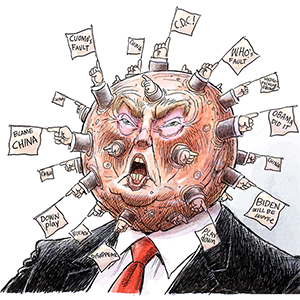A divisive factory farm battle in southern Minnesota takes center stage in new book
Published in Books News
Sonja Trom Eayrs, a Twin Cities attorney, grew up on a farm outside Blooming Prairie, Minnesota. A decade ago, Eayrs started waging a litigation campaign in Dodge County to compel local governments to enforce the rules against the growth of massive hog operations.
While small victories in court were ultimately swallowed on appeal, Eayrs has now penned a memoir-ish look back on her fight that put a target on her back in her small rural hometown. The book also offers an unsparing view of consolidation in the agriculture industry.
In “Dodge County, Incorporated,” Eayrs says she and her family “witnessed firsthand the effects of Big Ag that are rarely discussed in mainstream food and farm media.”
She recently spoke with Minnesota Star Tribune agriculture reporter Christopher Vondracek.
Q:We both grew up in southern Minnesota. What’s your thought about how Blooming Prairie might differ from when you grew up?
A:A couple of years ago, I’m visiting my mother in the nursing home, and I find out from a relative they’re spreading manure on the edge of Blooming Prairie. There’s a Facebook page called, “You Know You’re From Blooming Prairie When.” So I put on there, “you know you’re from Blooming Prairie when it smells like pig [feces], and it’s mid-October.” The first two comments are supportive. Then, boom. The hog mafia realizes [what I’ve said], and, whoa, Facebook is blowing up. So, what’s it like today? Anybody who is aligned with corporate agriculture is in a power position. Everyone else remains quiet.
Q:I often hear from farmers who say heavy-handed government regulation puts the small farmer out of business. Why talk about “corporate ag,” and not governmental farm policy or a desire for affordable food?
A:Corporate agriculture has harnessed our government policy. You look, there is no such thing as cheap food. Because we are all subsidizing this. They externalize all these costs, and we are all [paying] as taxpayers.
Q: In the book, you include a photo of your grandfather, a Norwegian immigrant. You might not call it “corporate,” but weren’t farmers of his generation trying to make a buck, too?
A: They were looking for opportunity. They were also looking to build communities. That was an era of care, community, and compassion. We’ve lost all that. So now it becomes this fight for corporate profit.
Q: Your book argues those profits get sent outside Dodge County?
A: All you have to do is get in your car and drive through rural America, get off the road on these lesser-known roads, and you’re going to find factory farms embedded on township roads that should never be there. You’re going to find a trail of closed schools, closed churches. You know what’s in their place? Museums.
Q: Or antique shops.
A: Or antique shops.
Q:I try to think of farming in our backyard as if I grew up in Chicago near the steel mills. Even if you despised those mills, what happened to those areas after they closed? A rust belt. So are you worried that, if you overturn bigger farms and meat-processing, that we might lose that line of economic vitality?
A: The best thing that can happen in a small town is a small meat market. If we want to revitalize these areas, we need to restart the engines, and put farmers back on the land. We need to put animals back on the land, get them out of these factories, because when you put animals back on the land, the people will follow.
Q:How has U.S. Department of Agriculture Secretary Tom Vilsack been doing?
A: [He’s] trying to keep a foot on both the industrial, corporate side and on the small farmer side. But by funding corporate agriculture, with our federal tax dollars, all you’re doing is facilitating and promoting this corporate system.
Q:Do you see any meaningful movement away from that model? And what happens to family farms?
A: The industry has made big strides by referring to these operations as “family farms.” Can you imagine, your farm has been in your family for 100 years, and the only way for you to stay in operation is you’ve got to put in a great big manure pit? We have to get people educated. And people have to get politically involved — on both sides of the aisle. Because at the end of the day, these small towns are dying.
Q:On a more hopeful note, what’s the status of your family farm?
A: We’re still farming. Both of my parents are now deceased. But my younger brother, Jim, and I are the trustees. Jim does the operational side. I do the business side. I pay the bills. We farm corn and soybeans. We have 760 acres. I’ll take you on a ride. Our farm is operational, and we’re surrounded by a dozen swine factory farms in a 3-mile radius. But I’m in the courtroom frequently. I tell people I’m not afraid of conflict, which is why, I think, I’m in a unique position to tell this story.
____
Dodge County, Incorporated
By: Sonja Trom Eayrs.
Publisher: Univ. of Nebraska Press, 344 pages, $24.95.
©2024 The Minnesota Star Tribune. Visit at startribune.com. Distributed by Tribune Content Agency, LLC.













Comments